A.Vogel search
When the internal search is activated, personal data such as your IP address is transmitted to our search engine Cludo. Data is thus transferred to a third country. Please click here if you want to display the internal search. You can find more information on data protection here: Privacy policy.
How to grow strawberries
Although strawberries are typically thought of as being grown in a warm climate, growing strawberries in Canada is also successful and increasing in popularity. Strawberries grow well in a range of soils, and can tolerate different temperatures, although the fruit is sweetest when exposed to warm weather. They also grow well in pots or indoors, making them an easy plant to grow regardless of the space and conditions available to you.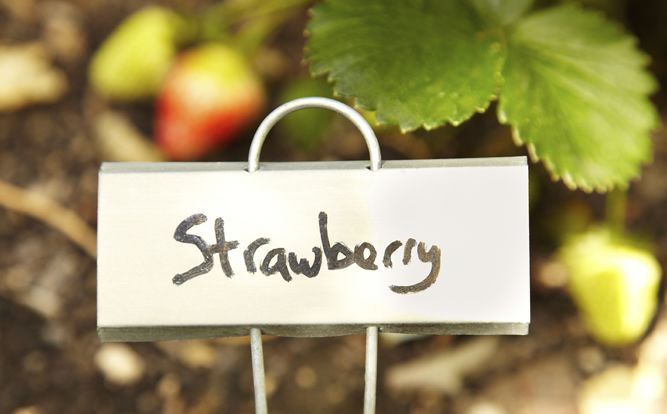
Choosing a Plot
Other than Alpine strawberries which prefer semi-shade, strawberries grow best in full sun and in soil that drains well. Though strawberries can tolerate soil which is light and sandy, to heavy clay, if the soil becomes waterlogged this increases the chances of the strawberry plants rotting. A soil pH of around 6 is best for soil and strawberries should not be planted in areas where raspberries, potatoes and tomatoes have grown recently as this increases the risk of the plants becoming diseased.
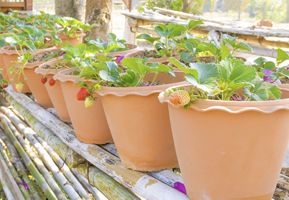 Strawberries can be grown in containers. This should work well, as it is more convenient with regard to space and can reduce susceptibility of plants to diseases. Strawberries can be grown in containers as small as 25cm (10in) in diameter and 20cm (8in) deep, although when planted in bigger containers will require less maintenance. The container should be positioned in direct sunlight and in as warm a spot as possible, keeping the strawberry plants out of direct wind as this can inhibit pollination.
Strawberries can be grown in containers. This should work well, as it is more convenient with regard to space and can reduce susceptibility of plants to diseases. Strawberries can be grown in containers as small as 25cm (10in) in diameter and 20cm (8in) deep, although when planted in bigger containers will require less maintenance. The container should be positioned in direct sunlight and in as warm a spot as possible, keeping the strawberry plants out of direct wind as this can inhibit pollination.
Planting Strawberries
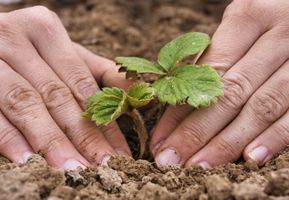 Strawberry runners look like small roots with few leaves. The crown of the runner should be planted at soil level, covering the roots but leaving the leaves exposed to the air. If planting in rows, space the rows about 57cm (23in) apart, placing each plant about 35cm (14in) apart. If using a 30cm (12in) container, it is best not to plant more than three strawberry plants at any one time.
Strawberry runners look like small roots with few leaves. The crown of the runner should be planted at soil level, covering the roots but leaving the leaves exposed to the air. If planting in rows, space the rows about 57cm (23in) apart, placing each plant about 35cm (14in) apart. If using a 30cm (12in) container, it is best not to plant more than three strawberry plants at any one time.
When to plant strawberries is determined by the type of strawberry. In general however, June-bearing varieties can be planted in spring or in late summer, Alpine strawberries are best in late spring and Ever-bearing strawberries respond well to being planted in the autumn.
Nurturing your Plants
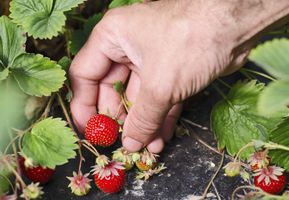 Looking after your plants well is the key to ensuring a good crop of strawberries. Alfred Vogel stated that ‘I had to conclude from this observation that warmth and sunlight are mainly responsible for sweetness. Feeding also plays an important part; our strawberries are given a sufficient quantity of organic lime, which would account for their being sweeter than if the soil was not fed at all.’
Looking after your plants well is the key to ensuring a good crop of strawberries. Alfred Vogel stated that ‘I had to conclude from this observation that warmth and sunlight are mainly responsible for sweetness. Feeding also plays an important part; our strawberries are given a sufficient quantity of organic lime, which would account for their being sweeter than if the soil was not fed at all.’
Strawberry plants need to be well-watered, but not soggy, as this can cause the plants to rot. Generally speaking, if the top inch of soil is dry, the plants need to be watered.
Some people place straw around their strawberry plants from late May as this suppresses weeds, reduces attacks from slugs, and keeps strawberries from falling onto the ground and rotting.
Before the fruit turns red, it may be worth protecting your plants from the birds, so that you don’t lose your crop of fruit. A fine mesh over the plants is usually effective, as this still allows for insects to pollinate the plants.
If you have planted in containers, it is worth re-potting each year in fresh soil if possible. This is best done in early spring, and you should have three or four years of good crop.
Problems When Growing Strawberries
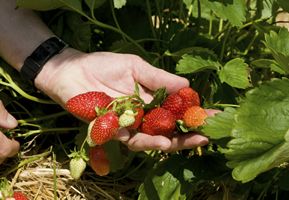 There are a few problems which can crop up when growing strawberries, though in general, these can be prevented by looking after your plants well, and rotating your plot regularly. This will reduce susceptibility of the plants to diseases. While you do not want your plants to dry out, over watering can lead to the plants rotting.
There are a few problems which can crop up when growing strawberries, though in general, these can be prevented by looking after your plants well, and rotating your plot regularly. This will reduce susceptibility of the plants to diseases. While you do not want your plants to dry out, over watering can lead to the plants rotting.
Problems can arise if the plants are exposed to frost or cold weather. Try to protect the plants as much as possible. If it is cold, the plants can be insulated with mulches.
If you notice any leaves that are turning yellow or mouldy remove them so that they do not affect the rest of the plant. Additionally, remove fruit once it is ripe, so that it does not turn rotten on the plant.
Harvesting Strawberries
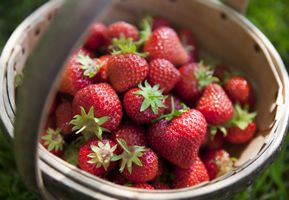 Four to six weeks after the flower blossoms, the fruit will be ready for harvesting. This is once the fruit has turned from green to white to red. Once strawberries are red through they are ripe and ready to pick. If the fruit is picked too early, it will not ripen.
Four to six weeks after the flower blossoms, the fruit will be ready for harvesting. This is once the fruit has turned from green to white to red. Once strawberries are red through they are ripe and ready to pick. If the fruit is picked too early, it will not ripen.
Rather than pulling the berries from the plant, cut or pinch and break off the stalk just above the fruit, as this will prevent damage to the fruit and plant. It is important to remove all ripe fruit, otherwise it will rot and potentially damage the plant. Harvest will last for about three weeks, and fresh fruit can be kept in the fridge for up to 5 days, or frozen for up to two months.
A.Vogel Blog – Natural and Healthy
Inspiration for a healthy life!



